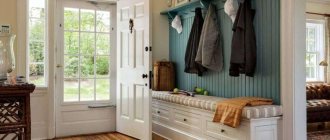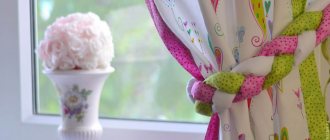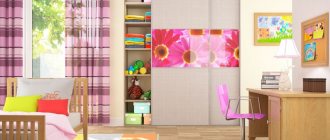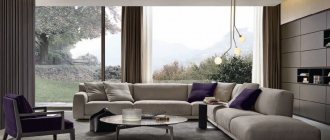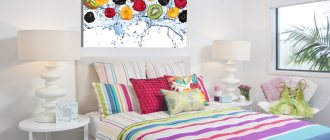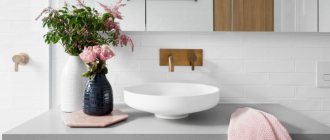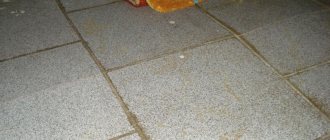Waiting for a new addition to the family is an exciting and happy period, filled with pleasant chores. One of the first tasks that future parents solve concerns the arrangement of the bedroom with the obligatory purchase of a crib. The first months and years after birth, the child is highly dependent on adults. He needs the presence of mom and dad nearby, so there is no need to rush to assign him to his private room. Experts recommend installing a baby crib in the room where the parents sleep: this way the baby feels protected and comfortable, and the mother is less worried and tired. In addition, living conditions may develop in such a way that it is impossible to provide a separate room. Therefore, it is very important to design a shared bedroom so that it is comfortable for both large and small residents.
Requirements for arranging a place for a child
A comfortable sleeping area is the key to a baby’s sound, sweet sleep and health, which automatically implies a calm environment for all family members. What rules should parents consider when choosing a crib, related accessories and other furniture for the bedroom?
- A separate cot is required. Even if the mother plans to sleep together with the baby, it is much more convenient and safer to put him, if necessary, in a crib equipped with protective walls.
- It is worth considering the presence of a changing table, as well as a small chest of drawers or a cabinet for children's things.
- All materials must be environmentally friendly and safe: cotton, natural wool, if there are no allergies, linen and silk, wood, high-quality plastic, metal protected by textile screens.
- There should be no sharp corners or dangerously protruding elements on the crib.
- In addition to high backs, furniture must be equipped with removable or stationary side walls, which are a lattice or mesh structure.
- The mattress becomes moderately hard and elastic, ensuring an even position during sleep. But parents are increasingly refusing to use side soft screens, as they are unsafe and are an additional source of dust.
- It is necessary to provide free space from the parents' bed to the baby's sleeping place, so that even in a half-asleep state you can quickly get to it.
- It is best to place the crib with the head of the bed against one of the walls - this way the child feels more protected. You can equip a canopy or a sliding screen, which will create the feeling of a cozy nest.
When equipping a room, you should limit the number of house plants. Too rich aromas of flowers can negatively affect the condition of the baby, and their pollen can cause an allergic reaction. You need to add flowers to the bedroom interior gradually and very carefully, especially in the space next to the crib.
Room zoning
It’s great if the parent’s bedroom has enough space, and you can easily equip it with a separate corner for the baby. But not all Russian citizens can boast of spacious houses or apartments. Proper zoning of space allows you to harmoniously distribute the necessary things without creating chaos. It is also important to adhere to the design originally chosen for the room. You can complement strict classics with playful ruffles or color the Scandinavian style with bright patterns. But you should not combine elements that are strikingly different in style.
The first thing you should do is make a plan. The arrangement of furniture in the room may be different. The main condition is that zoning must provide its own space, albeit small, for the child and parents.
- If the area of the room allows, it is worth highlighting part of the space by installing a partition. This way, the child and parents will each have their own small room. To do this, you can use a plasterboard wall, chest of drawers, cabinet or rack. You should not install furniture with shelves on which something stands or lies close to the crib - accidental shaking may cause things to fall and cause injury.
- If the dimensions of the apartment do not allow you to create a partition, there is another excellent option for creating separate zones - using screens, canopies or blackout curtains. This type of fencing creates a wonderful effect of a closed, cozy space. You can move it freely around the room, remove it when the screen is no longer needed, change it if you get bored with the color or pattern.
If the fencing option is not acceptable for some reason, there are several other simple ways to visually highlight zones. For this purpose, color and lighting solutions and decorative elements are used.
Choosing a place for a crib
The layout of the furniture in the room should take into account the interests of all family members, as well as prospects for the future. Children grow up and move into their own premises. Therefore, there is no need to make drastic alterations in the room - in 1-3 years everything will have to be returned to its previous form. The main object in the bedroom is the large bed on which mom and dad sleep. It should remain that way.
To place children's furniture, you can use one of the popular options:
- next to the parent’s bed, along it or across it, on the side where the mother usually sleeps. Sometimes a narrow passage is left between pieces of furniture. You can install a bedside table, chair or small table. Or they place one wall close to each other, removing the fence, whichever is more convenient. The convenience of this setup is that the baby actually sleeps next to the mother; she does not need to jump up and run to feed him at night or change diapers. Often everything is done automatically. Disadvantage: cramped conditions, risk of bumping in the dark, as well as inconvenience in making and making beds;
- installed opposite the parent's room, at the foot or against the wall, allows you to watch the baby without getting out of bed, and access to it is open from three sides;
- a good option is to be located in one of the corners. It is best to place it farthest from the door, so as not to disturb the baby during sleep;
- if the room is spacious enough, the parents sleep on a folding sofa, or a bed that can be retracted into a wall or closet, you can arrange a sleeping place in the center or by leaving a narrow passage along the far wall. The main advantage of this location is that you can approach from any direction.
When choosing a place for a baby, you should consider the presence of windows and doors. Make sure that it is not exposed to direct rays of the sun or the heat of radiators, electric heaters, that it is not in a draft from open vents or an air conditioner, or close to a window or door. Also, it is dangerous to install the crib next to sockets or lighting fixtures - a little fidget may well be curious about what is there.
Dimensions of children's beds depending on the design option
There are many options for children's beds. Each model is designed for a child of a certain age. In the pictures of children's beds you can see the standard sizes of the products. The smallest design has dimensions of 40x80 cm. This is a cradle bed, which is designed for a baby up to 6 months old.
The average sizes of one-and-a-half children's beds reach 120-150 cm in width
A standard wooden children's bed for a newborn has a size of 60x120 cm. The height of the sleeping bed of such designs can vary from 50 to 70 cm, which is determined by the age of the child. The single classic model is characterized by minimum standard parameters of 70x130 cm. The maximum length of the bed can reach 170 cm, which is typical for sliding models. There are non-standard products with a width of 80-90 cm. A teenage single bed design can have a minimum size of 90x180 cm. However, models with a length of 200 cm are more popular.
A bunk bed for two children most often has a height of 1.5-1.8 m. The sizes of the beds may vary. The width of the second tier bed is usually 80-90 cm, length – 200 cm. The lower bed is 20 cm shorter than the upper one. This is because the older child will sleep upstairs and the younger one will sleep downstairs.
The standard width of a single bed is 70 cm, and the length varies from 130 to 170 cm
Wall decoration
What should be the design of the walls of the bedroom in which you plan to place a crib? Particular attention should be paid to the quality of finishing. It is necessary to use only materials that are safe for the baby and nursing mother:
- paper and non-woven (cellulose) wallpaper. Fabric options made of linen or rope are also possible, but you will have to take care of regular dust cleaning;
- decorative plaster with various textures, ceramics;
- painting with latex or water-based paints.
All these materials do not emit harmful substances and do not cause allergic reactions. They last a long time and do not require special care.
It is better to choose a neutral, light color for the main coating:
- white-grayish, light beige;
- pinkish or the color of baked milk;
- bluish frosty;
- pale green or light green;
- peach or agave shade.
If the bedroom was originally decorated in too bright, red or, conversely, gloomy-dark colors, it is better to make a small renovation by the time the baby is born.
The area for the baby can be allocated in several ways:
- original drawings or bright accents, cartoon characters on the wall;
- a more saturated or lightened base shade;
- interesting compositions of flowers, butterflies, animals, patterns or inscriptions;
- in a different color.
To create the desired effect, you can use painting on the wall, another type of wallpaper or plaster, wall panels, and other materials.
Types of beds by material of manufacture
Wood is rightfully considered the best material for a children's bed. A budget option is furniture made from MDF.
Wooden products have such advantages as environmental friendliness, durability, reliability, and strength. In such a crib, the baby’s body will “breathe.” The leading position is occupied by models made of valuable wood species.
The most popular materials for making beds for children:
- Pine. This is the most affordable option.
- Alder. Allows you to get furniture of a noble color.
- Beech. The beech bed is durable, does not make squeaks, does not crack or begin to wobble over time.
- Ash. It has an interesting structure and gives the furniture a rich look.
- Oak. Allows you to get a luxurious bed that will last for more than one generation.
Note! Ideas for decorating walls with photo wallpaper in a children's room (100 photos)
Lighting
Proper lighting is very important for the baby and parents:
- bright lamps, ceiling chandeliers and the sun should not shine directly into the child’s eyes or blind the mother. The main lighting should be located slightly to the side, and the bedside area should be equipped with dim, matte light;
- While the baby is sleeping, it is necessary to dim the lights, including daylight;
- it is necessary to equip functional illuminated areas: next to the crib, at the changing table and feeding area, a night light or dim lighting;
- It is better to purchase a ceiling chandelier with the ability to adjust its intensity.
Comfortable day and night lighting creates a cozy, relaxing environment in the bedroom.
Play area
A baby from 1 year old needs space for active activities. A separate area is allocated in the room next to the cradle, and a playpen is often installed. Starting from two years of age, a developmental zone is needed. Toys and accessories are placed in boxes, books are placed on an open shelf.
Functional shared bedroom Source dizainexpert.ru
